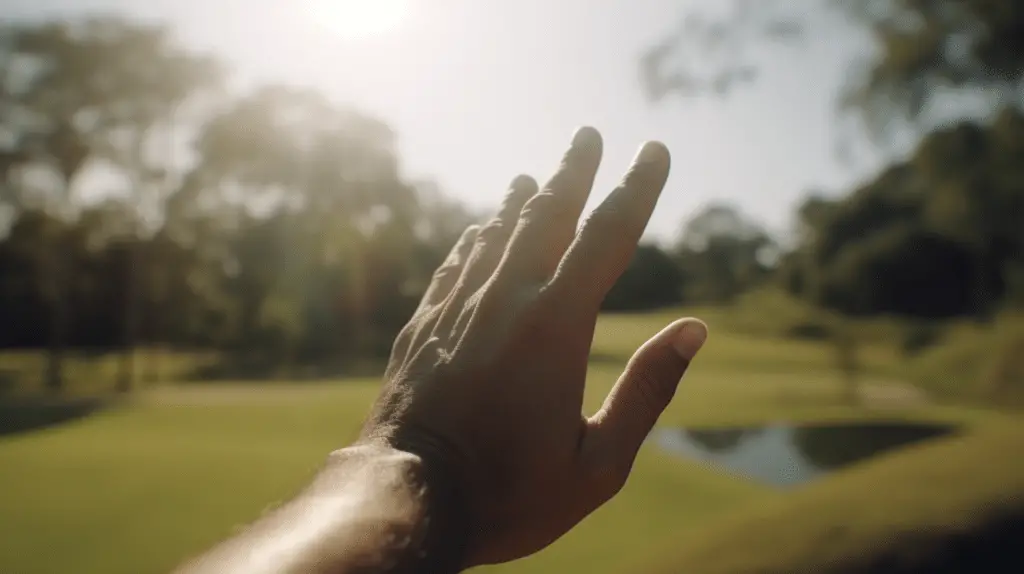Last Updated on June 11, 2023
Golfers of all ability levels can benefit from learning how to properly use the capitate joint in their golf swing. This small but powerful joint, found on the thumb side of your hand, has a major impact on swinging accuracy and power. Unfortunately, many players don’t realize just how much they are missing out by not taking advantage of this important feature. In this article, we’ll explore why using the capitate joint is essential for successful golf swings and provide tips on how you can incorporate it into yours. You’ll be amazed at how quickly you notice drastic improvements in your game! So what are you waiting for? Let’s get started and learn how to use the capitate joint correctly in your golf swing today!
The Role Of The Capitate Joint In A Golf Swing

The capitate joint plays an important role in a golf swing. It is located at the base of the thumb and acts as an anchor point for the hand, allowing it to grip firmly while swinging with precision. With each movement of the clubhead, the capitate joint helps keep the wrist and arm stable and secure. This stability allows for increased accuracy and power during a golf swing. Additionally, this joint also provides support when taking follow-through shots after contact with the ball has been made. By providing additional strength and control through its range of motion, players are able to make consistent swings on their drives or putts. Ultimately, by stabilizing both arms in a natural position throughout all points of a golfer’s swing, the capitate joint ensures that every shot is performed accurately and powerfully.
Benefits Of Utilizing The Capitate Joint
The capitate joint is an important part of the golf swing and can be beneficial when used correctly. Here are some of the advantages of utilizing this joint:
- Improved power – The utilization of the capitate joint in your swing helps increase power by allowing for a more efficient transfer from your legs to upper body, resulting in increased speed and distance.
- Accuracy – Utilizing the capitate joint will help you have better control over where your club travels during the swing, improving accuracy.
- Reduced fatigue – By using the capitate joint correctly, it reduces stress on other parts of the body, which may become fatigued as a result of incorrect technique.
- Better balance – Using the capitate joint correctly can also help with maintaining good balance throughout your entire swing, making it easier to stay centred.
- Drill exercises – There are several drill exercises that focus on incorporating and mastering use of the capitate joint into a golfer’s game such as shoulder turns and wrist hinge drills. These drills should be done regularly to ensure proper form and execution while playing rounds or practising at home.
Overall, properly utilizing the capitate joint in your golf swing has many benefits, including improved power, accuracy, reduced fatigue, better balance, and practice drills that all help make you a better player!
Key Steps For Executing A Proper Golf Swing
The key to executing a proper golf swing is correctly engaging the capitate joint. This small but powerful joint plays an important role in how much power you can generate and accuracy of your shots. It’s essential that it be engaged during the backswing, downswing, and follow-through of each shot.
| Backswing | Downswing | Follow-Through |
|---|---|---|
| Start with feet shoulder width apart | Rotate hips while keeping arms close to body & head still | Step through ball w/ left foot & allow right hand to rotate around shoulders until clubhead reaches waist height |
| Raise clubhead directly up into air as if reaching for ceiling, keep arms straight & wrists cocked slightly backward | Swing lower body first toward target; Let hands lead as they pass by hip on way to impact zone | Finish with weight fully transferred onto front leg, torso facing towards target & arms extended outward away from body |
It’s all about using the big muscles (hips) during the backswing and downswing movements and allowing them to guide your smaller muscles (wrists) when driving the ball. Engaging your capitate joint will help you maintain control throughout these motions which will result in more accurate, longer drives. Keep practising these steps so that you can develop consistency with your shots!
Drill Exercises To Strengthen The Capitate Joint
After executing a proper golf swing, it is important to strengthen the capitate joint in order to maximize accuracy and power. The capitate joint can be strengthened by performing specific drills and exercises. To begin, start with basic wrist flexion exercises: holding the club at one end and then bending it up and down for 10-15 repetitions. Additionally, hold the club out straight from your body as if you were taking a golf shot and rotate your wrists inwardly, followed by outwardly. Aim to perform this exercise 8-10 times per set on each side of the wrist.
The next drills involve gripping strength. Start by grasping the club tightly with both hands while alternating between squeezing tight and releasing slowly; try doing 2 sets of 15 reps each hand. You can also take two clubs and press them together lengthwise or across – again aiming for 8-10 reps in each direction per set. Finally, practice regular grip changes on the club itself while hitting or swinging lightly into an impact bag – switching your grips every few swings helps build grip endurance over time. All these exercises should help strengthen your capitate joint when done correctly and consistently throughout practice sessions.
Common Mistakes While Utilizing The Capitate Joint In A Golf Swing
The capitate joint is an important part of a successful golf swing. It helps to create power and accuracy in the shot, but it can be easy for players to make mistakes when trying to utilize this joint correctly. Over-striding is one of the most common mistakes made while using the capitate joint during a golf swing. When over-striding, the player takes too large of a step with their stride leg, which can cause them to move off balance and throw off their timing.
Another common mistake is having an incorrect grip. If the golfer’s hands are not placed on the club properly they won’t be able to generate enough power as they need from this joint. Lastly, incorrect timing can also lead to problems with utilizing the capitate joint effectively. The golfer needs to time their backswing perfectly so that all parts of their body work together at the same time for maximum efficiency and distance in their shots.
In order for players to successfully use the capitate joint in a golf swing, they must practice proper technique and avoid making any of these common errors. Proper form requires dedication and focus from each individual player in order for them to reach peak performance levels on the course.
Tips To Improve Consistency When Utilizing The Capitate Joint In A Golf Swing
The capitate joint is critical for a successful golf swing, but if it isn’t used correctly mistakes can be made. In order to ensure consistency in your golf swing and improve performance, there are several tips you should follow when utilizing the capitate joint:
| Tip | Explanation | Results |
|---|---|---|
| Maintain Proper Posture | Keep spine straight and maintain an athletic stance throughout the entire swing. This will help keep the arms in sync with body movement. | Improved accuracy and power output. |
| Utilize Arm Movements Separately | Swing arms independently of each other while ensuring that they move together at the same pace. This allows for more control over club head speed. | Increased precision and greater ability to shape shots. |
| Use Capitate Joint as Axis Point | Allow wrist action to occur around this point during backswing by hinging wrists slightly inward and outward for increased leveraged power on downswing. | More powerful swings leading to better ball striking accuracy. |
By following these tips, you’ll be able to use the capitate joint efficiently and effectively when swinging a golf club which will lead to improved consistency overall during your game play. Through proper posture, arm movements, and using the capitate joint as an axis point, you’ll have enhanced control over your shot making, resulting in a more consistent game play experience!
Frequently Asked Questions
What Type Of Injury Can Result From Improperly Using The Capitate Joint In A Golf Swing?
When it comes to improper use of the capitate joint in a golf swing, there are potential injuries that can occur. Golfers who do not properly utilize this joint can be at risk for various types of pain and discomfort. From chronic inflammation to pinched nerves, these issues can persist even after the golfer has made changes to their technique or equipment.
Injuries related to the capitate joint come from over-utilizing this part of the body during a swing; when too much strain is put on the area, it becomes vulnerable to injury. This could result in swelling, soreness and tenderness in the affected area as well as decreased range of motion. Additionally, incorrect usage may cause tendonitis or bursitis which can lead to extreme levels of discomfort and potentially limit one’s ability to play without experiencing pain or stiffness afterwards.
The best way for golfers to avoid any type of injury due to improper use of the capitate joint is by ensuring they understand how to correctly make use of this part of their bodies while playing. Additionally, proper stretching before each round will help reduce tension and improve flexibility so that if an incorrect move is made while swinging, damage won’t be done. Taking care of your body should always be a priority if you want to keep up with what life throws at you!
How Can I Tell If I Am Engaging The Capitate Joint Correctly?
When it comes to the capitate joint, proper engagement is key in a golf swing. Understanding and executing the correct technique when engaging this particular joint can make all the difference between an accurate and powerful shot and one that doesn’t quite reach its target. As such, knowing how to tell if you are properly engaging your capitate joint is essential for any golfer who wants to take their game to the next level.
To ensure proper engagement of your capitate joint during a golf swing, start by focusing on your mechanics. Pay attention to where your hands and arms are positioned relative to each other throughout the entire stroke—from address through follow-through—and be mindful of keeping them aligned correctly with regard to both height and width in order to allow for maximum power transfer from body movement into club head speed at impact. Additionally, focus on making sure that your wrists remain cocked slightly back at set up before unhinging them quickly yet smoothly as you begin your downswing and approach impact. These two techniques should help ensure that you are using the capitate joint fully while avoiding any potential injury or detrimental effects on ball flight accuracy.
In summary, successfully engaging the capitate joint in a golf swing requires concentration and practice. Focus on maintaining good posture throughout the entire motion of the stroke, pay attention to keeping your hands, arms and wrists aligned correctly in relation to each other, and ensure that they move together fluidly through each stage of execution until completing the follow-through phase post-impact. With these tips in mind, you’ll be able to confidently use your capitate joint effectively every time you step onto the course!
How Often Should I Practice Drills To Strengthen The Capitate Joint?
Strengthening the capitate joint is an important part of any sport that requires precision and power, such as golf. How often should one practice drills to strengthen the capitate joint? This depends largely on individual goals for improvement.
For individuals looking to work on their golf swing, practising drills to strengthen the capitate joint can help improve accuracy and power in the movements. Drills such as wrist curls or planks are effective ways of targeting this joint specifically. These drills could be practiced several times a week, depending on how much time one has available – even just 5-10 minutes a day can make a difference. Additionally, implementing these exercises into warm ups before playing rounds of golf may also help reduce fatigue during play.
Practicing capitate joint drills regularly will not only benefit performance in sports like golf but it can also increase overall strength and dexterity while reducing pain and injury risk related to overuse injuries. To get maximum improvements from these exercises, consistency is key; setting regular sessions dedicated solely to improving strength around the capitate joint will ensure progress is made quickly and efficiently.
Conclusion
I’ve learned a lot about using the capitate joint in a golf swing. If I don’t use it properly, I could risk injuring my wrist or elbow. To make sure I’m engaging it correctly, I can practice drills to strengthen the joint and increase power.
The best way for me to do so is by practicing regularly and focusing on form when performing these exercises. Additionally, if there are any sports that involve proper use of the capitate joint, like tennis or baseball, then including those activities into my routine would be beneficial as well.
Finally, I should never forget how important this joint is for an effective golf swing. With consistent practice and diligence in ensuring correct form, I’m confident that my game will improve with each session.


